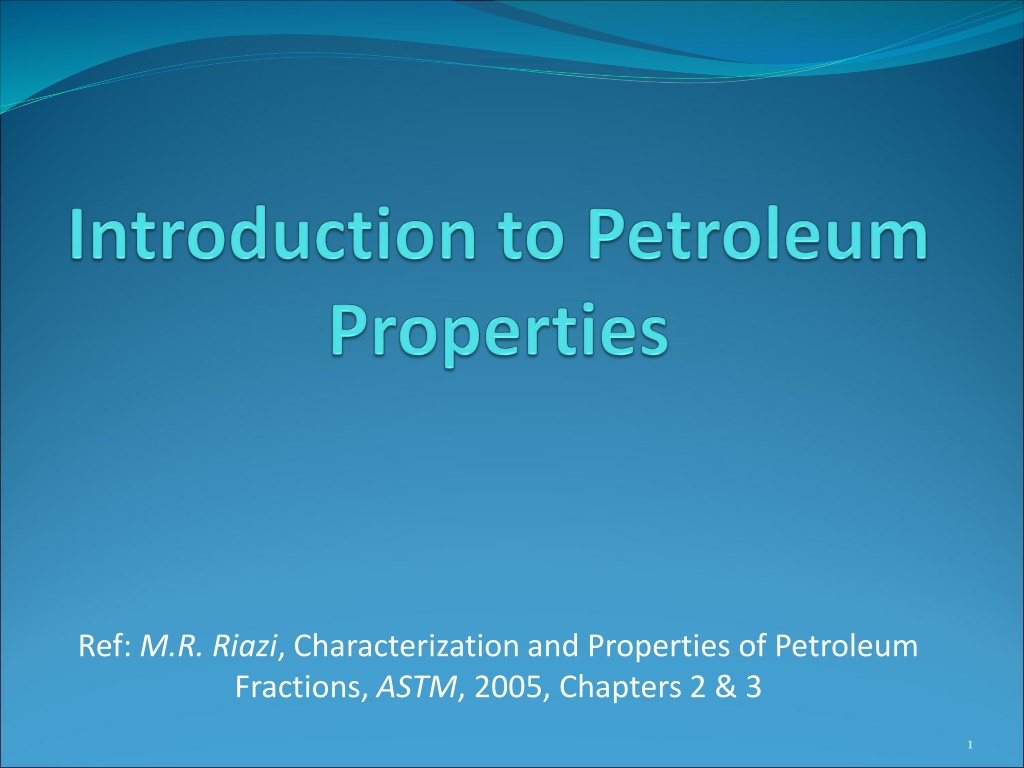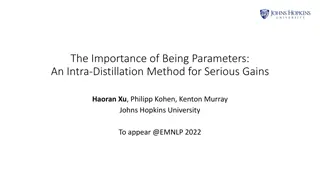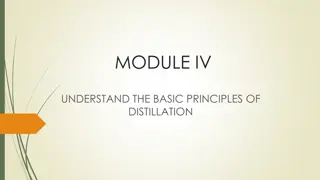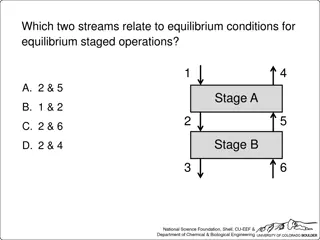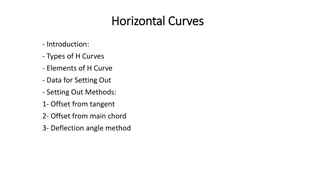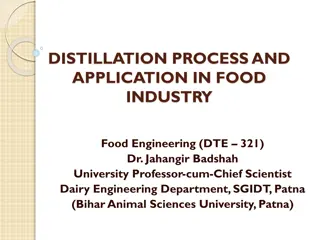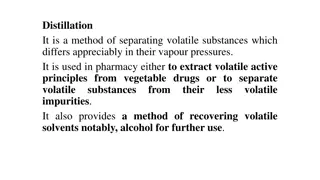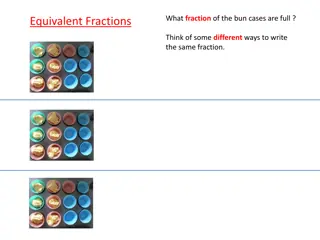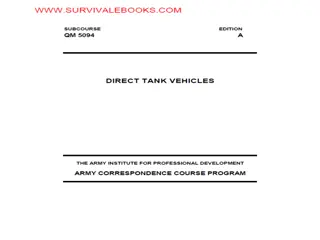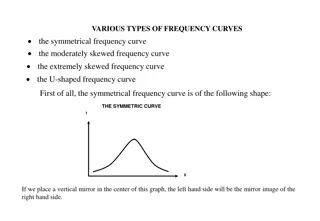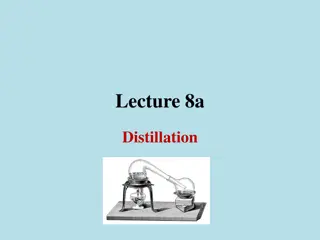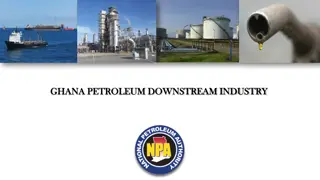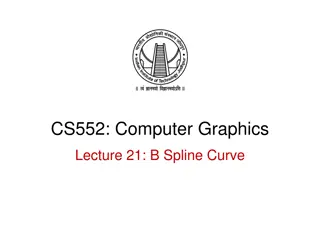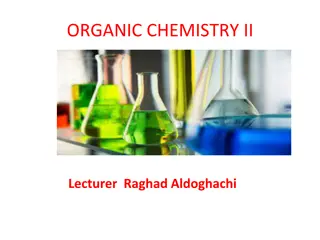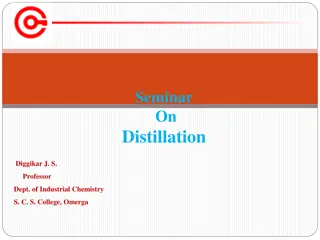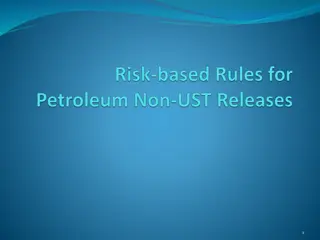Understanding Petroleum Fraction Distillation Curves
Characterization and properties of petroleum fractions are essential for understanding their behavior, particularly through distillation curves. These curves depict the boiling points of crude oil or petroleum fractions, highlighting components' volatility ranges. Various methods like ASTM D86, True Boiling Point, Simulated Distillation, and Equilibrium Flash Vaporization help measure and report boiling points accurately. The significance of Initial Boiling Point (IBP) and Final Boiling Point (FBP), as well as the challenges associated with high-temperature cracking effects, are crucial considerations in analyzing distillation curves.
Download Presentation

Please find below an Image/Link to download the presentation.
The content on the website is provided AS IS for your information and personal use only. It may not be sold, licensed, or shared on other websites without obtaining consent from the author. Download presentation by click this link. If you encounter any issues during the download, it is possible that the publisher has removed the file from their server.
E N D
Presentation Transcript
Ref: M.R. Riazi, Characterization and Properties of Petroleum Fractions, ASTM, 2005, Chapters 2 & 3 1
Distillation curves For a crude oil or a petroleum fraction of unknown composition, the boiling point may be presented by a curve of temperature versus vol% (or fraction) of mixture vaporized. The boiling point of the lightest component in a petroleum mixture is called initial boiling point (IBP) and the boiling point of the heaviest compound is called the final boiling point (FBP). In some references the FBP is also called the end point. 2
Distillation curves The difference between FBP and IBP is called boiling point range or simply boiling range. Petroleum fractions with wider boiling range contain more compounds than fractions with narrower boiling range. Crude oils have boiling ranges of more than 550 oC but the FBPs are not accurate. For heavy residues and crude oils the FBPs may be very large or even infinite as the heaviest components may never vaporize at all. Generally, values reported as the IBP and FBP are less reliable than other points. 3
Distillation curves There are several methods of measuring and reporting boiling points (distillation curves) of crude oil and petroleum fractions. Some of these methods are: 1- ASTM D 86 2- True boiling point (TBP) 3- Simulated distillation (SD) or ASTM D 2887 4- Equilibrium flash vaporization (EFV) 5- ASTM D 1160 4
Distillation curves ASTM D 86 ASTM D 86 is one of the simplest and oldest methods of measuring and reporting boiling points of crude oil and petroleum fractions. The test is conducted at atmospheric pressure with 100 mL of sample and the result is shown as a distillation curve with temperatures at 0, 5, 10, 20, 30, 40, 50, 60, 70, 80, 90, 95, and 100% volume vaporized. For crudes and heavy products, temperatures are reported at maximum of 90, 70, or even 50% volume vaporized. This is due to the cracking of heavy hydrocarbons at high temperatures. 5
Distillation curves ASTM D 86 The cracking effect is significant at temperatures above 350 oC, however, ASTM D 86 temperatures reported above 250 oC should be used with caution. Corrections applied to consider the effects of cracking are applicable from 250 to 500 oC however, these procedures have not been widely used and generally have not been confirmed. An apparatus to measure distillation of petroleum fractions by ASTM D 86 method is shown below. 6
Distillation curves ASTM D 86 7
Distillation curves True Boiling Point ASTM D 86 distillation data do not represent actual boiling point of components in a petroleum fraction. Atmospheric true boiling point (TBP) data are obtained through distillation of a petroleum mixture using a distillation column with 15-100 theoretical plates at relatively high reflux ratios (1-5 or greater). The high degree of fractionation in these distillations gives accurate component distributions for mixtures. The lack of standardized apparatus and operational procedure is a disadvantage, but variations between TBP data reported by different laboratories for the same sample are small. 8
Distillation curves True Boiling Point The IBP from TBP curve is less than the IBP from ASTM D 86 curve, while the FBP of TBP curve is higher than that of ASTM curve. Therefore, the boiling range based on ASTM D 86 is less than the actual true boiling range. 9
Distillation curves ASTM D 2887 A distillation curve produced by GC is called a simulated distillation (SD) and the method is described in ASTM D 2887 test method. Simulated distillation method is simple, consistent, and reproducible and can represent the boiling range of a petroleum mixture without any ambiguity. Distillation curves by SD are presented in terms of boiling point versus wt% of mixture vaporized because in gas chromatography composition is measured in terms of wt% or weight fraction. SD curves are very close to actual boiling points shown by TBP curves. 10
Distillation curves ASTM D 1160 For crude oils and products such as heavy gas oils that contain heavy compounds and may undergo a cracking process during vaporization at atmospheric pressure, distillation data are measured at reduced pressures, 1, 2, 10, or 50 mmHg. The experimental procedure is described in ASTM D 1160 test method. ASTM D 1160 distillation data are measured more accurately than ASTM D 86 since it is conducted at low pressure. For this reason ASTM D 1160 curves are closer to TBP curves at the same pressure base. 11
K UOP The Watson characterization factor (Kw) is one of the oldest characterization factors originally defined by Watson et al. of the Universal Oil Products (UOP) in mid 1930s. For this reason the parameter is sometimes called UOP characterization factor and is defined as / 1 3 T = = o where T normal boiling point b K R w b SG The naphthenic hydrocarbons have Kw values between paraffinic and aromatic compounds. In general, aromatics have low Kw values while paraffins have high values. 12
K UOP The Watson K was developed in 1930s by using data for the crude and products available in that time. Now the base petroleum stocks in general vary significantly from those of 1930s. However, because it combines two characterization parameters of boiling point and specific gravity it has been used extensively in the development of many physical properties for hydrocarbons and petroleum fractions. 13
RVP Reid vapor pressure (RVP) is the absolute pressure exerted by a mixture at 37.8 oC (100 oF) at a vapor-to-liquid volume ratio of 4.The RVP is one of the important properties of gasolines and jet fuels for blending of products. RVP is also a useful parameter for estimation of losses from storage tanks during filling or draining. The apparatus and procedures for standard measurement of RVP are specified in ASTM D 323 test method. In general, true vapor pressure is higher than RVP because of light gases dissolved in liquid fuel. 14
Freezing and Melting points For a pure compound the freezing point is the temperature at which liquid solidifies at 1 atm pressure. Similarly the melting point is the temperature that a solid substance liquefies at 1 atm. A pure substance has the same freezing and melting points; however, for petroleum mixtures, there are ranges of melting and freezing points versus percent of the mixture melted or frozen. for petroleum mixtures the initial freezing point is greater than the initial melting point. 15
Pour Point Pour point of a petroleum fraction is the lowest temperature at which the oil will pour or flow when it is cooled without stirring under standard cooling conditions. Pour point represents the lowest temperature at which an oil can be stored and still capable of flowing under gravity. When temperature is less than pour point of a petroleum product it cannot be stored or transferred through a pipeline. Test procedures for measuring pour points of petroleum fractions are given under ASTM D 97 and ASTM D 5985 methods. 16
Cloud Point Cloud point is the lowest temperature at which wax crystals begin to form by a gradual cooling under standard conditions. At this temperature the oil becomes cloudy and the first particles of wax crystals are observed. The standard procedure to measure the cloud point is ASTM D 2500. Low cloud point products are desirable under low-temperature conditions. Wax crystals can plug the fuel system lines and filters, which could lead to stalling aircraft and diesel engines under cold conditions. Cloud points are measured for oils that contain paraffins in the form of wax and therefore for light fractions (naphtha or gasoline) no cloud point data are reported. 17
Petroleum Properties Flash pointfor a hydrocarbon or a fuel is the minimum temperature at which vapor pressure of the hydrocarbon is sufficient to produce the vapor needed for spontaneous ignition of the hydrocarbon with the air with the presence of an external source, i.e., spark or flame. The standard procedure to measure the Flash point is ASTM D 93. Flash point is an important parameter for safety considerations, especially during storage and transportation of volatile petroleum products (i.e., LPG, light naphtha, gasoline). The surrounding temperature around a storage tank should always be less than the flash point of the fuel to avoid possibility of ignition. 18
Fire Point & Autoignition Flash point should not be mistaken with fire point, which is defined as the minimum temperature at which the hydrocarbon will continue to burn for at least 5 s after being ignited by a flame. Autoignition temperature is the minimum temperature at which hydrocarbon vapor when mixed with air can spontaneously ignite without the presence of any external source. Values of autoignition temperature are generally higher than flash point. This is particularly important from a safety point of view when hydrocarbons are compressed. Standard test is ASTM D 2155. 19
Flammability Range To have a combustion, three elements are required: fuel (hydrocarbon vapor), oxygen (i.e., air), and a spark to initiate the combustion. One important parameter to have a good combustion is the ratio of air to hydrocarbon fuel. The combustion does not occur if there is too much air (little fuel) or too little air (too much fuel). This suggests that combustion occurs when hydrocarbon concentration in the air is within a certain range. This range is called flammability range and is usually expressed in terms of lower and upper volume percent in the mixture of hydrocarbon vapor and air. 20
Octane Number Octane number is a parameter defined to characterize antiknock characteristic of a fuel (gasoline and jet fuel) for spark ignition engines. Octane number is a measure of fuel's ability to resist auto-ignition during compression and prior to ignition. Higher octane number fuels have better engine performance. The octane number of a fuel is measured based on two reference hydrocarbons of n-heptane with an assigned octane number of zero and isooctane (2,2,4- trimethylpentane)with assigned octane number of 100. 21
Octane Number There are two methods of measuring octane number of a fuel in the laboratory; motor octane number (MON)and research octane number (RON). TheMONis indicative of high-speed performance (900 rpm) and is measured under heavy road conditions (ASTM D 357). The RON is indicative of normal road performance under low engine speed (600 rpm) city driving conditions (ASTM D 908). The arithmetic average value of RON and MON is known as posted octane number (PON). Isoparaffins and aromatics have high octane numbers while n-paraffins and olefins have low octane numbers. 22
Octane Number Generally there are three kinds of gasolines: regular, intermediate, and premium with PON of 87, 90, and 93, respectively. Improving the octane number of fuel would result in reducing power loss of the engine, improving fuel economy, and a reduction in environmental pollutants and engine damage. There are a number of additives that can improve octane number of gasoline or jet fuels. These additives are tetra-ethyl lead (TEL), alcohols, and ethers. 23
Cetane Number For diesel engines, the fuel must have a characteristic that favors auto-ignition. The ignition delay period can be evaluated by the fuel characterization factor called cetane number (CN). The shorter the ignition delay period the higher CN value. The cetane number is defined as: CN = vol% n-cetane + 0.15(vo1% HMN) Where n-cetane (n-C16H34) has a CN of 100, and heptamethylnonane (HMN) has a CN of 15. The cetane number of a diesel fuel can be measured by the ASTM D 613 test method. 24
Cetane Number Higher cetane number fuels reduce combustion noise and permit improved control of combustion resulting in increased engine efficiency and power output. Higher cetane number fuels tend to result in easier starting and faster warm-up in cold weather and can cause reduction in air pollution. The product distributed in France and Europe have CN in the range of 48-55. In the United States and Canada the cetane number of diesel fuels are most often less than 50. Cetane number of diesel fuels can be improved by adding additives such as 2-ethyl-hexyl nitrate or other types of alkyl nitrates. 25
Aniline Point Aniline point for a hydrocarbon or a petroleum fraction is defined as the minimum temperature at which equal volumes of liquid hydrocarbon and aniline are miscible. The aniline point is important in characterization of petroleum fractions and analysis of molecular type. The aniline point is also used as a characterization parameter for the ignition quality of diesel fuels. It is measured by the ASTM D 611 test method. Aromatics have very low aniline points in comparison with paraffins, since aniline itself is an aromatic compound (C6H5-NH2) and it has better miscibility with aromatic hydrocarbons. 26
Carbon Residue When a petroleum fraction is vaporized in the absence of air at atmospheric pressure, the nonvolatile compounds have a carbonaceous residue known as carbon residue (CR). Therefore, heavier fractions with more aromatic contents have higher carbon residues while volatile and light fractions such as naphthas and gasolines have no carbon residues. There are three different test methods to measure carbon residues, Ramsbottom (ASTM D 524), the Conradson (ASTM D 189) and microcarbon (ASTM D 4530). In most cases carbon residues are reported in wt%. 27
Smoke Point The smoke point (SP) is a maximum flame height at which a fuel can be burned in a standard wick-fed lamp without smoking. It is expressed in millimeters and a high smoke point indicates a fuel with low smoke-producing tendency. Measurement of smoke point is described under ASTM D 1322. Smoke point is a characteristic of aviation turbine fuels and kerosenes and indicates the tendency of a fuel to burn with a smoky flame. Higher amount of aromatics in a fuel causes a smoky characteristic for the flame and energy loss due to thermal radiation. 28
